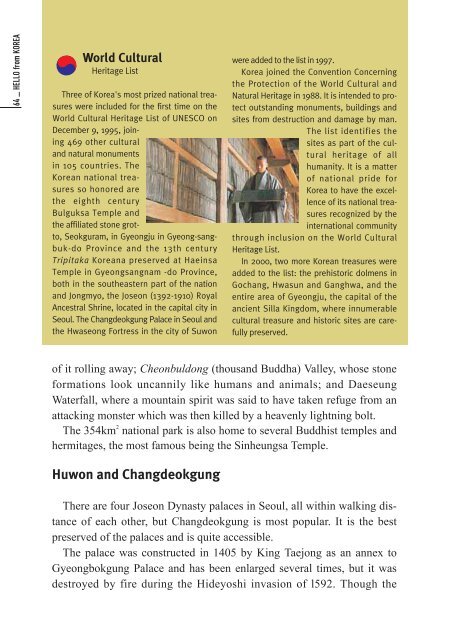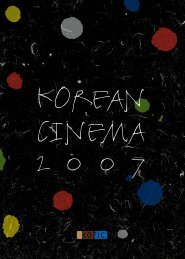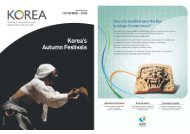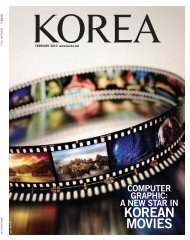HELLO from KOREA
Hello-Eng(3.3) - Korea.net
Hello-Eng(3.3) - Korea.net
- No tags were found...
Create successful ePaper yourself
Turn your PDF publications into a flip-book with our unique Google optimized e-Paper software.
64 _ <strong>HELLO</strong> <strong>from</strong> <strong>KOREA</strong><br />
World Cultural<br />
Heritage List<br />
Three of Korea's most prized national treasures<br />
were included for the first time on the<br />
World Cultural Heritage List of UNESCO on<br />
December 9, 1995, joining<br />
469 other cultural<br />
and natural monuments<br />
in 105 countries. The<br />
Korean national treasures<br />
so honored are<br />
the eighth century<br />
Bulguksa Temple and<br />
the affiliated stone grotto,<br />
Seokguram, in Gyeongju in Gyeong-sangbuk-do<br />
Province and the 13th century<br />
Tripitaka Koreana preserved at Haeinsa<br />
Temple in Gyeongsangnam -do Province,<br />
both in the southeastern part of the nation<br />
and Jongmyo, the Joseon (1392-1910) Royal<br />
Ancestral Shrine, located in the capital city in<br />
Seoul. The Changdeokgung Palace in Seoul and<br />
the Hwaseong Fortress in the city of Suwon<br />
were added to the list in 1997.<br />
Korea joined the Convention Concerning<br />
the Protection of the World Cultural and<br />
Natural Heritage in 1988. It is intended to protect<br />
outstanding monuments, buildings and<br />
sites <strong>from</strong> destruction and damage by man.<br />
The list identifies the<br />
sites as part of the cultural<br />
heritage of all<br />
humanity. It is a matter<br />
of national pride for<br />
Korea to have the excellence<br />
of its national treasures<br />
recognized by the<br />
international community<br />
through inclusion on the World Cultural<br />
Heritage List.<br />
In 2000, two more Korean treasures were<br />
added to the list: the prehistoric dolmens in<br />
Gochang, Hwasun and Ganghwa, and the<br />
entire area of Gyeongju, the capital of the<br />
ancient Silla Kingdom, where innumerable<br />
cultural treasure and historic sites are carefully<br />
preserved.<br />
of it rolling away; Cheonbuldong (thousand Buddha) Valley, whose stone<br />
formations look uncannily like humans and animals; and Daeseung<br />
Waterfall, where a mountain spirit was said to have taken refuge <strong>from</strong> an<br />
attacking monster which was then killed by a heavenly lightning bolt.<br />
The 354km 2 national park is also home to several Buddhist temples and<br />
hermitages, the most famous being the Sinheungsa Temple.<br />
Huwon and Changdeokgung<br />
There are four Joseon Dynasty palaces in Seoul, all within walking distance<br />
of each other, but Changdeokgung is most popular. It is the best<br />
preserved of the palaces and is quite accessible.<br />
The palace was constructed in 1405 by King Taejong as an annex to<br />
Gyeongbokgung Palace and has been enlarged several times, but it was<br />
destroyed by fire during the Hideyoshi invasion of l592. Though the
















